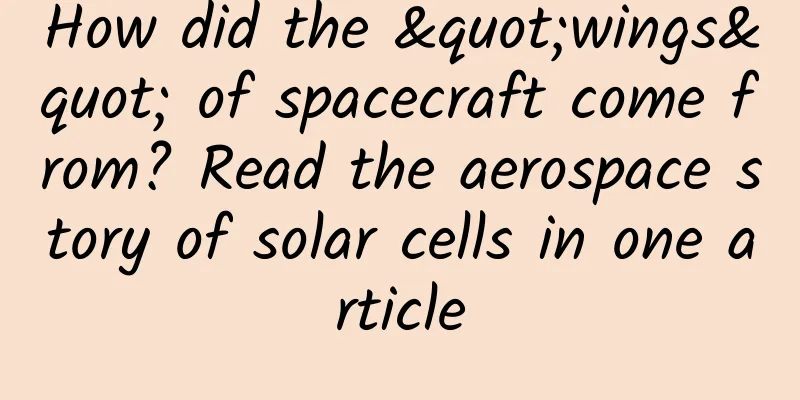How did the "wings" of spacecraft come from? Read the aerospace story of solar cells in one article

|
People who are interested in aerospace are very familiar with solar cells, which are commonly known as "solar wings" or "solar panels". The aerospace field is the first field in which humans use solar energy in a large scale and in a comprehensive manner. Without decades of exploration, development and application of aerospace technology, today's huge photovoltaic industry may not have been born. Solar cells are now often called photovoltaic materials. Although some deep space probes are already using radioisotope power sources, the vast majority of spacecraft, including those landing on the surface of the moon and Mars, are still using solar cells because they are safe and reliable, the technology is mature, and there is no concern about nuclear pollution. In deep space exploration activities, huge solar cell arrays can also be used as power, relying on the pressure of sunlight for propulsion. The International Space Station's solar panels are the largest photovoltaic panels ever used in space At present, there are two types of solar cell materials used by humans: silicon and gallium arsenide. How are solar cells used in spacecraft? The first practical silicon solar cell was introduced by Bell Labs in April 1954. The initial efficiency was only 6%. However, Bell Labs' core business was communications, so it did not invest too much research and development resources in solar cells. The first chip developed by Bell Labs in 1954 On April 25, 1954, Bell Labs announced to the public that it had successfully developed a silicon solar cell. At the time, the U.S. military was secretly considering developing and launching a satellite. Bell's solar cell caught the attention of James O'Connell, commander of the U.S. Signal Corps. Soon, O'Connell arranged for Dr. Hans Ziegler, chief researcher of power equipment at the U.S. Army Corps of Engineers, to visit Bell Labs. Dr. Ziegler was so astonished by what he saw at Bell Labs that he told his colleagues after his visit: "Silicon solar cells may well become such an important source of electricity that we could have solar cells on the roofs of all the buildings in our towns and cities to meet all of America's electricity needs." Dr. Ziegler Ziegler and his staff immediately set out to investigate. In space, they wrote, solar cells can get rid of ground restrictions such as night and bad weather, and "operation above the Earth's atmosphere will provide an ideal environment for solar converters." Solar cells are relatively light, and solar energy as a fuel can be used 24 hours a day in space. In addition, silicon solar cells can be used for many years, unlike other power sources that will run out in less than a month. They therefore concluded: "For longer operating time and limited weight, the photovoltaic principle looks most promising." At that time, the U.S. Navy won the competition to develop the first U.S. satellite. However, the Navy had no interest in using solar cells, saying that they were "uncontrolled and the industrial base has not yet been fully established." The Navy's decision angered Ziegler, and in order to "let mankind benefit from this invention as soon as possible," he told the idea of solar cells to a civilian group of famous American scientists who were responsible for overseeing the United States' nascent space program. These scientists sided with Ziegler and said that "it is vital to use solar cell systems in space." The scientists pressured the Navy to design a solar power system for the "Pioneer Project." Bell granted the production license to Spectrolab, which manufactured the first batch of solar arrays in accordance with the requirements of the US military. In order to test whether they can withstand the vibration and space environment of space launch, Ziegler and others encapsulated the solar cells in a box protected by heavy glass, installed them on the nose cones of two rockets, and launched them to a high enough altitude to simulate the satellite operating environment. Five solar cells are installed on the rocket's nose cone. The solar cells performed well during both launches. "They were powerful enough to power the satellite instruments, and they were not affected by surface friction temperatures as the rocket traveled through the atmosphere at high speed," the test report said. But the successful test did not impress the Navy, which publicly said at least the first four satellites would likely use conventional chemical batteries as a power source. However, by August 1957, the Vanguard program was in trouble. In order to launch quickly, the U.S. military decided to launch a batch of dummy satellites with nothing inside except a radio transmitter. Ziegler said the revised plan provided "an excellent new opportunity for solar cells" because there was "considerable weight and volume sitting empty." The Navy eventually gave in. After several failed attempts, the first satellite with solar cells was put into orbit in 1958. The Navy had no confidence in solar cells, so it put in some chemical batteries. Nineteen days later, the New York Times reported that "the chemical batteries were exhausted and the solar unit was operating." Because of its solar cells, Vanguard satellites lasted longer than the Soviet Union's Messenger satellite, which stopped working after just a few weeks in space. Vanguard's long operation more accurately mapped the locations of South Pacific islands and enabled geophysicists to better determine the shape of the Earth. Solar cells used in pioneer satellites The greater role of the Pioneer satellite is the breakthrough in the use of solar energy in space. Today, solar cells have become one of the most important equipment in space programs. Pioneer satellite and 4 solar cells Spectrolab entered the satellite solar cell market with the Pioneer program and has since achieved several milestones. These include the Explorer 6 reconnaissance satellite, the first to feature a full solar array, which provided the first photo of the Earth from space in 1959. The first geostationary communications satellite, Simcon, featured body-mounted solar cells. The Apollo 11 mission in 1969 deployed the first solar panel on the moon. These were all Spectrolab products. They also supplied 275,000 silicon cells for the International Space Station. This is the largest photovoltaic panel ever used in space, with a total output of 200 kilowatts. The successful use of solar cells on various spacecraft has made people realize the value of solar cells. Dr. Hans Ziegler calculated that using solar cells to charge battery packs is much lighter than carrying batteries and launching them. At that time, the conversion efficiency of silicon solar cells was about 10%. An American company called Spectrum Laboratories began to develop solar cells specifically for space applications. Since then, solar cells have become standard equipment for artificial satellites. By the 1970s, silicon cell efficiency had improved to about 12%, and a 6-centimeter-diameter silicon solar cell could produce 0.25 volts and 1 ampere of current at a distance of one astronomical unit from the sun, the distance from the sun to the earth. How are solar cells becoming more powerful as we head into deep space? As the demand for more powerful and efficient satellites increased in the 1970s and 1980s, solar cell manufacturers, represented by Spectrolab, developed increasingly powerful solar cells. Around the turn of the century, gallium arsenide replaced silicon as the primary material for space solar cells, with an efficiency of about 30%, quickly becoming the mainstream of the industry. The most efficient currently are multi-junction photovoltaic cells. They use a combination of several layers of indium gallium phosphide, gallium arsenide, and germanium, and can exceed 39.2% efficiency under non-concentrated AM1.5G lighting, and can exceed 47.1% efficiency when using concentrated AM1.5G lighting. Today, Spectrolab alone is able to produce nearly 500,000 watts (more than 30 high-power satellites) of multi-junction solar cells and panels each year. The solar cells used in the US Opportunity and Spirit Mars rovers are also Spectrolab products. The Opportunity Mars rover was designed to have a lifespan of only 90 days, but it has been working for 14 years. So far, NASA has launched several probes to the surface of Mars, including landers, rovers, and helicopters. On these probes, we can see the development and changes of solar cell technology. The three Mars rovers in the picture are from left to right: Spirit, Sojourner, and Curiosity. @Mars Rover The Mars rover needs electricity to maneuver, drive scientific instruments, communicate with Earth, and even more electricity if it wants to drill on Mars. Currently, the main source of power for the Mars rover is still multi-panel solar arrays. They look a bit like "wings", but their main purpose is to generate electricity, not to fly. With the launch of different generations of Mars rovers, the solar cells used are constantly updated to achieve higher and higher performance. The Sojourner rover landed on Mars on July 4, 1997. It was designed to last only a week, but it actually operated for a full 85 days. During a clear Martian day, Sojourner's silicon solar arrays can generate about 140 watts of power for four hours. The rover needs about 100 watts (equivalent to an old-fashioned tungsten light bulb) to operate. Sojourner Rover as seen by the Mars Pathfinder probe Of course, 140 watts is the most ideal state. There are also seasonal changes on Mars. When it reaches the aphelion, the intensity of sunlight will be lower due to the distance. Mars, like the Earth, has an inclined axis of rotation, which brings seasonal changes to Mars. In addition, due to the dust covering the solar array, the power generation capacity of the "Sojourner" solar array may be reduced to about 50 watts. Therefore, "Sojourner" also carries a pair of 40 ampere-hour lithium batteries, which are charged by solar cells during the day. At night, the operation of the Mars rover depends on it. By the time of Spirit and Opportunity, triple-junction gallium arsenide solar panels had matured. These panels have three layers and are more powerful than the single-layer panels on Sojourner. When the sun is strongest, the solar panels on Spirit and Opportunity can provide about 900 watt-hours of power in a Martian day. Artist's impression of the Spirit rover on Mars Dust coverage is the biggest problem for solar panels on Mars. With no way to clean them, dust accumulation will continually reduce solar output, which was a major factor in NASA's eventual loss of contact with the Spirit and Opportunity rovers. Because this problem is difficult to solve, the subsequent "Curiosity" and the currently operating "Perseverance" both use radioactive isotope thermal power sources. @Insight lander sets record for power generation on Mars On November 26, 2018, NASA's InSight probe successfully landed on Mars, and its dual solar panel array set a record for daily power generation on Mars. InSight Mars Lander On its first Martian day, InSight generated 4,588 watt-hours of electricity from solar power, far exceeding the 2,806 watt-hours of the Curiosity rover. In third place was the Phoenix lander, which generated about 1,800 watt-hours of electricity per day from solar power. The solar array of InSight is called UltraFlex, which means "super flexible". It is a product of Orbital Sciences ATK, which has now been acquired by Northrop Grumman. It is a fan-shaped structure that unfolds into a circle. It is also used on the Phoenix lander and the Cygnus cargo spacecraft. According to Northrop Grumman, UltraFlex has an efficiency of 29.5%. The battery cells are manufactured by SolAero Technologies. In addition, the InSight also carries two 25 ampere-hour lithium-ion batteries. The two solar arrays of InSight are each 2.2 meters in diameter. When they are open, the entire lander is about the size of a "large convertible from the 1960s." The pair of batteries can provide 600 to 700 watts of peak power on a clear day, about half of that on Earth. Even if covered in dust, it can still provide at least 200 to 300 watts of peak power. @Smart Mars Helicopter In 2020, when NASA's Mars rover "Perseverance" landed on Mars, it brought a unique device: the small helicopter Ingenuity. The flight of this unmanned helicopter has given people a new understanding of the application and maintenance of solar energy on Mars. The atmosphere on Mars is thin, and to fly an object heavier than air here, the rotational power required is much greater than on Earth. So, can solar cells support such a large power demand? Ingenuity Mars helicopter is being tested on the ground The solar panels of Ingenuity are provided by a company called SolAreo, which uses the so-called "inverted deformed multi-junction panel" technology. This type of solar panel not only has an efficiency of 33%, exceeding the 30% of traditional gallium arsenide cells, but is also more than 40% lighter than conventional space-grade solar panels. The light weight and ultra-high efficiency of the panels make it possible for Ingenuity to fly. The solar panels of Ingenuity are about 425 mm wide and 165 mm long. Its power generation capacity is not enough to directly support flight, so the lithium battery pack must be fully charged before flying. Every Martian day, the energy provided by the solar cells can be used for a 90-second flight. In the on-site photos, the solar panels of Ingenuity look dusty, but NASA does not seem to be worried, saying that it has little impact. It turns out that the solar panels of Ingenuity are installed above the rotor. This brings a huge benefit. We mentioned in the previous article that the dust coverage caused the efficiency of the solar cells of the Mars rover to become increasingly poor. However, during the flight of Ingenuity, there will be a relatively large airspeed, which is equivalent to using wind to blow the solar cells, which can blow away the dust and restore the power generation capacity. This gives people greater confidence to realize the flight of the rotorcraft in the Martian atmosphere. Successful innovation, what will solar cells look like after their “transformation”? In the foreseeable future, solar cells will continue to be the main source of electricity for artificial satellites, spacecraft, space stations and probes. In the early stages of the lunar base, a large number of solar cells will also be deployed to support the operation of the base. As for the deployment of lunar nuclear power plants, it is still under discussion. Even if it is realized, it will definitely be ranked behind solar cells. There are two key performance indicators for solar panels. The first is specific power, which is the power produced divided by the mass of the solar array. Another key indicator is stacking efficiency, which is the deployed power produced divided by the stacked volume, which indicates whether the array can be easily installed in a launch vehicle. Of course, there is a third key indicator, which is the cost per watt. In order to increase specific power, typical solar panels on spacecraft use tightly packed rectangular solar cells, covering nearly 100% of the solar panel's visible area from the sun. However, if the spacecraft uses body-mounted batteries, that is, the solar panels are attached to the outer surface of the satellite body, the area visible to the sun will be much less. To get the most power, the solar panels are designed to move as the spacecraft moves. So no matter where the spacecraft is pointed, the panels are always pointed at the sun. Sometimes, though, satellite operators will intentionally tilt the panels a little to avoid direct alignment with the sun. This is often because the onboard batteries are full or the payload doesn't need that much power. The International Space Station sometimes tilts the solar panels to reduce orbital drag. Prolonged exposure to sunlight causes the performance of photovoltaic cells to degrade by about one to two percent per year, and more rapidly when exposed to particle radiation from solar flares. Space contains varying levels of electromagnetic and ionizing radiation. There are four sources of radiation: Earth's radiation belts (also known as the Van Allen belts), galactic cosmic rays (GCRs), the solar wind, and solar flares. The Van Allen belts and solar wind contain mostly protons and electrons, while GCRs are mostly high-energy protons, alpha particles, and heavier ions. Due to these types of radiation, the efficiency of solar panels will decrease over time, and the rate of decline depends on the solar cell technology and the location of the spacecraft. For borosilicate glass panel coverings, the efficiency loss can be between 5 and 10% per year. Other glass coverings, such as fused quartz and lead glass, reduce the efficiency loss to less than 1% per year. Therefore, the research and development and improvement of solar cells will continue for a long time. A recent successful innovation is the flexible unfoldable solar cell. Flexible Deployable Solar Array is abbreviated as ROSA. Traditionally, solar cells for aerospace use are expensive, bulky, and often very complicated to operate. ROSA can be compact and affordable, and can be used for a variety of scientific and commercial missions from low-Earth orbit to interstellar travel. Today, ROSA has been used on the International Space Station and in the Double Asteroid Redirection Mission. In the future, it is also planned to be used on the Earth-Moon Orbit Space Station, and some commercial satellites are also discussing the use of ROSA. The company that developed ROSA is called Redline Aerospace. It was originally developed by Deployable Space Systems (DSS) with the support of NASA's Space Technology Directorate. In 2021, Redline Aerospace acquired DSS to continue developing the application market for ROSA. Astronauts install ROSA on the International Space Station Ken Steele, vice president of business development at Redline Aerospace, said that the sun is the largest energy source in space, producing more energy per second than humans have consumed in the past 70 years. Most spacecraft use solar panels to harness the sun's continuous energy and provide energy for various needs, such as thermal energy and payload operations. However, there are two key factors in the design of solar panels, namely size and reliability, which are difficult to optimize. The size of the panel affects the launch cost, and high reliability is required to withstand the harsh space environment, including temperature fluctuations, radiation, and micrometeoroid impacts. Therefore, humans urgently need to develop new concepts of solar cells to solve the above problems. The emergence of ROSA solves these problems. Compared with traditional solar cells, ROSA has a compact structure and can be rolled up like a carpet for easy launch, but the area after unfolding is quite large. In addition, ROSA is scalable and modular, which can meet various mission requirements and can be used on small satellites or in deep space missions. The ROSA after deployment on the International Space Station is at an angle to the old battery. Matt, technical director of ROSA on the International Space Station at Red Line Aerospace, said that the deployment of large solar arrays usually uses motors and cable systems, which requires a large number of personnel and high-power electrical systems. In contrast, ROSA can use the deformation potential energy in the composite boom to deploy itself. And the use of composite booms will greatly reduce the possibility of mechanism jamming or motor failure. Although ROSA is smaller than traditional solar arrays, it uses high-efficiency solar cells, and a single solar panel can generate more than 30 kilowatts of power. In the future, concentrators may be used to increase power generation capabilities. In addition, the structural rigidity of the composite boom is relatively good, and it can withstand dynamic environments, vibrations, and debris or micrometeoroid collisions, providing reliability for long-term missions. |
<<: 600 years! Protected since the Ming Dynasty, what’s so special about this forest?
Recommend
How does a P2P platform choose high-quality channels?
As we all know, the cost of acquiring P2P custome...
Huawei and Xiaomi laptops released, Yang Yuanqing breathed a sigh of relief
On the afternoon of July 27, Xiaomi's noteboo...
How to get the new version of AppStore traffic bonus before iOS11 is released
Introduction: For APP promotion and operation per...
Practical case: How to build high-quality user portraits?
If there is any core ability that a product manag...
British drama film "Nymphomaniac" series 2 (2013) extended version HD English subtitles Baidu cloud download
British drama film "Nymphomaniac" serie...
How to sort out the core process of the activity?
I don’t know if you have noticed that after you h...
iPhone 6s is close to perfection if it does these 6 things
Whether it is called "iPhone 6s/6s Plus"...
How is Pinduoduo’s crisis public relations?
Yesterday afternoon, Pinduoduo held an emergency ...
Business Week: How did Didi Chuxing squeeze Uber out of China?
Cheng Wei, founder and CEO of Didi Chuxing, recen...
Ang Lee's Father Trilogy: Eat Drink Man Woman, The Wedding Banquet, Pushing Hands HD Collection
When talking about Ang Lee’s most representative ...
How to use Douyin Blue V faster and more economically? Save yourself thousands after reading this!
Preface I wonder if you have noticed? The growth ...
How to tame a giant pterosaur that is bigger than the US F-16 Fighting Falcon?
Pterosaurs are probably the closest to dragons (d...
The first version of 5G standards will be released next month. Revealed: How are 5G standards established?
[[230666]] The 5G standard is composed of many te...
Middle-aged weight gain has nothing to do with metabolism! If you want to get rid of your "fat belly", follow these 3 dietary recommendations!
After entering middle age, "gaining weight&q...
New Bug Exposed in iOS 10.2: Say Goodbye to the Era of CDs?
According to a report by Cult of Mac, iOS 10.2 do...









